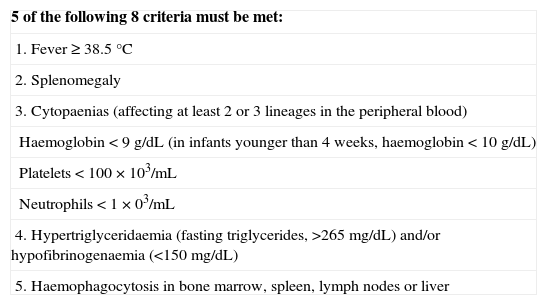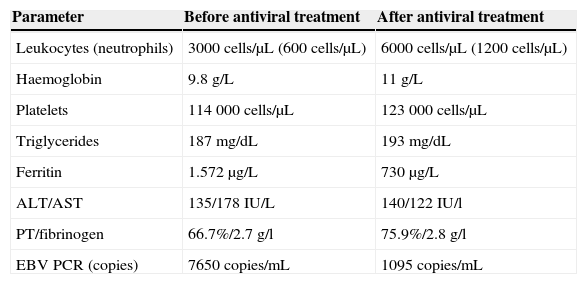The efficacy of thiopurine immunosuppressants in the treatment of inflammatory bowel disease (IBD) has been demonstrated, and thiopurines are the most commonly used drugs to maintain remission induced by exclusive enteral nutrition or steroids in paediatric patients with Crohn's (EC) disease. Their long-term use may facilitate the development of opportunistic infections by viruses such as Epstein–Barr virus (EBV). Thiopurine blocking of regulatory T cells enhances the cytotoxicity of EBV, leading to B-cell lymphoproliferation. In immunosuppressed patients, the manifestation of EBV may range from an infectious mononucleosis to a haemophagocytic lymphohistiocytosis (HLH).1
We present the case of a 14-year-old male patient with CD in clinical and laboratory remission following combined treatment with infliximab (IFX) and azathioprine (AZA) since diagnosis. In order to reduce the risk associated with dual immunosuppression, IFX was discontinued 10 months after initiating treatment, and the patient developed a high fever, odynophagia, submandibular lymphadenopathy and splenomegaly. Laboratory analysis revealed pancytopaenia and elevated levels of transaminases, triglycerides and ferritin (Table 1). Intravenous empirical antibiotic therapy was initiated due to the presence of febrile neutropaenia (500 cells/mm3) and was suspended after 72h following a negative blood culture and a positive Paul-Bunnell test. Epstein–Barr virus was detected by polymerase chain reaction (quantitative PCR), with a viral load of 7650 copies/mL. An incipient HLH in association with primary infection by EBV (initial test was negative at the time of CD diagnosis) was suspected, leading to discontinuation of AZA and initiation of empirical antiviral treatment with ganciclovir. At 72h, the clinical manifestations had improved, with a reduction in lymphadenopathy, improvement of pancytopaenia and a decrease in the viral load. Ganciclovir treatment was discontinued on the fifth day, when the patient had been afebrile for 48h. The patient was discharged seven days after admission after ruling out HLH, as he did not meet the full laboratory criteria2 (Table 2). Thirty-two days following the diagnosis of primary infection by EBV, the viral load was undetectable and monotherapy with IFX was resumed on an outpatient basis, and at present, 20 months after discontinuation of AZA, the patient remains in clinical and laboratory remission and has not developed any complications from the medication.
Diagnostic criteria for haemophagocytic lymphohistiocytosis.
| 5 of the following 8 criteria must be met: |
| 1. Fever≥38.5°C |
| 2. Splenomegaly |
| 3. Cytopaenias (affecting at least 2 or 3 lineages in the peripheral blood) |
| Haemoglobin<9g/dL (in infants younger than 4 weeks, haemoglobin<10g/dL) |
| Platelets<100×103/mL |
| Neutrophils<1×03/mL |
| 4. Hypertriglyceridaemia (fasting triglycerides, >265mg/dL) and/or hypofibrinogenaemia (<150mg/dL) |
| 5. Haemophagocytosis in bone marrow, spleen, lymph nodes or liver |
Laboratory parameters of the patient.
| Parameter | Before antiviral treatment | After antiviral treatment |
|---|---|---|
| Leukocytes (neutrophils) | 3000 cells/μL (600 cells/μL) | 6000 cells/μL (1200 cells/μL) |
| Haemoglobin | 9.8g/L | 11g/L |
| Platelets | 114 000 cells/μL | 123 000 cells/μL |
| Triglycerides | 187mg/dL | 193mg/dL |
| Ferritin | 1.572μg/L | 730μg/L |
| ALT/AST | 135/178IU/L | 140/122IU/l |
| PT/fibrinogen | 66.7%/2.7g/l | 75.9%/2.8g/l |
| EBV PCR (copies) | 7650copies/mL | 1095copies/mL |
It is known that children with IBD have certain characteristics that increase the risk of opportunistic infection (immunosuppressive treatment, malnutrition…). There are cases of infection by EBV with a fatal outcome in patients with CD during treatment with AZA. Biank et al.3 described four cases of HLH secondary to primary infection with EBV in EC. N’Guyen et al.4 reported a case of primary infection by EBV in which the patient was receiving treatment with AZA for EC and developed infectious mononucleosis, HLH and a B cell lymphoproliferative disorder. Francolla et al.5 published the first paediatric case of HLH secondary to EBV in EC during treatment with IFX and AZA. While there is no evidence of the beneficial effect of discontinuing immunosuppressants therapy in these cases, the European Crohn's and Colitis Organization (ECCO) recommends that, in patients that develop severe infection by EBV during treatment with thiopurines, antiviral therapy should be combined with the discontinuation of immunosuppressant therapy, which could lead to the spontaneous improvement of the process without any other intervention.6 This consensus document states that EBV IgG screening should be considered before initiation of immunomodulator therapy with thiopurines.
In our case, the early diagnosis and management with antiviral therapy and discontinuation of thiopurine treatment probably prevented the development of a haemophagocytic lymphohistiocytosis, which has the potential to become fatal.
Please cite this article as: Ruiz Hernández C, Sánchez Hernández D, Vila Miravet V, Pinillos Pisón S, Martin de Carpi J. Toxicidad medular secundaria a primoinfección por virus de Epstein-Barr en paciente con enfermedad de Crohn en tratamiento con tiopurínicos. An Pediatr (Barc). 2015;83:134–135.






